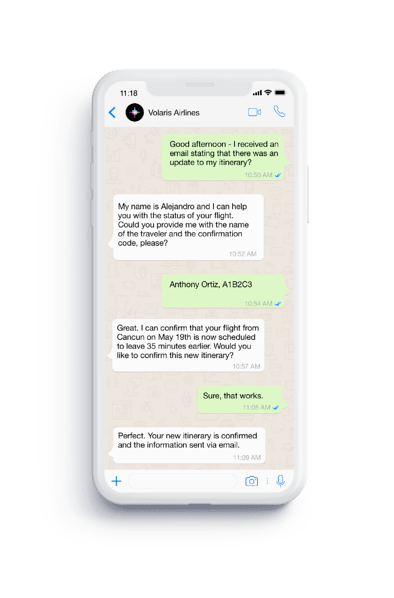The 5 Most Common Mistakes Companies Make When Engaging Customers on WhatsApp


WhatsApp is where millions of people go to connect with friends and family, and, increasingly, have conversations with companies too. With such a wide reach and instant familiarity, it’s an ideal customer engagement channel.
In fact, WhatsApp is the most popular private messaging app in over 100 countries with 2.2 billion active users worldwide. In 2021, it generated over $8.7 billion in revenue, almost all from WhatsApp Business, which enables organizations to engage with customers via private messaging.
Over the years, we’ve overseen the successful deployment of WhatsApp Business for thousands of our partners, whilst also seeing a fair number of businesses struggling to use the channel effectively. If you’re thinking of rolling out WhatsApp Business or you’re already using it for customer engagement, here is our list of the five most common mistakes you’ll want to avoid.
1. Using the same KPIs as other customer engagement channels
WhatsApp is asynchronous and it needs to be treated as such. Customers want to pick up conversations when it’s convenient for them. So, different KPIs should be used. A common one we see is the time it takes from first contact to resolution. This is difficult to apply to WhatsApp, as customers get on with their lives in between messages. A question asked to a company on the commute home might not even be seen until after dinner when the conversation carries on.
Agents will also be dealing with many conversations at the same time. With the way WhatsApp works, agents can handle multiple inquiries at once managing continuous conversations over the span of a service issue. Theoretically, agents can deal with an infinite number of conversations at the same time. So, we would expect things like average interaction times and resolution times to be lower compared to other channels.
2. Treating it like live chat
WhatsApp most definitely isn’t live chat. WhatsApp is asynchronous and doesn’t rely on an immediate response from either an agent or customer. A very common mistake we see is that conversations are closed off after a few minutes of non-response on WhatsApp, similar to how businesses manage live chat customer interactions. On live chat, customers expect a quick conversation with the agent, they’re already on the website and are told to stay in the conversation window. With WhatsApp, they send a message and pop their phone back in their pocket, and reply when they’re ready.
The other biggest difference is the ability to send pictures, documents and other attachments. Allowing customers to send a picture or screenshot of their issue is an incredibly valuable tool – a picture is worth a thousand words after all. And being able to send important and useful documents to customers is underutilized, with many companies still emailing or even posting a letter – a highly inefficient and costly solution.

WhatsApp enables a continuous messaging experience that’s convenient for customers
3. Not using automation
Automation is possibly the most powerful tool to add to the WhatsApp experience. It can be used to resolve less complex issues without human intervention or point the customer to the right answer elsewhere. This allows agents to do what they do best, and actually talk to the customers that need them most.
Automation enables organizations to:
Lower cost-per-contact: Bot-ready platforms that combine both adaptive automation and agent-assisted service result in fewer inquiries needing a human response and leave highly skilled agents free to handle more complex customer service needs.
Provide better customer service experiences: Automation of customer service inquiries results in quicker response and resolution times for customers, decreasing service effort and increasing customer loyalty.
Meet capacity through conversation containment: Service bots and virtual assistants help brands manage high-volume, low-effort queries. Used as a frontline triage, bots should resolve repetitive, simple issues while highly skilled agents are dedicated to high-value interactions—creating big savings in customer service costs.
4. Not enabling agent handoffs
Automation is great for helping customers get the answers they need quickly but it can’t resolve every issue. When a customer has a more complex inquiry, the bot needs to be able to handoff to a human agent. Far too often, we see bots that can’t hand inquiries on to a human agent and customers become frustrated that their experience is essentially a dead end.
A good bot will let customers know when a request is outside of its capabilities and provide the option of speaking with a human agent or hand over when a customer uses a phrase like “speak to agent”.
5. Not being conversational
Companies sometimes forget that they’re talking to real people on WhatsApp, and so the conversations can get a little weird. People use WhatsApp all the time – they’re used to chatting with friends and family, and this will also be apparent in conversations with businesses. Being super formal, robotic, and lacking personality, may turn customers off using the channel altogether.
Agents repeatedly asking for the same information is also an issue that we regularly see, as they don’t have access to customer history. Customers get caught in a cycle of increasing frustration and, in the end, give up on their inquiry completely. Agents and automation alike should be having real conversations, powered by historic customer information to ensure a seamless experience.
Engage Your Customers on WhatsApp
WhatsApp is a fantastic way to get customers to speak with you. It’s available everywhere, everyone knows how to use it, and it can be a powerful way to communicate, especially when you layer in automation. However, it has to be done right. It can’t be treated like any other channel. It’s a private conversation between your business and your customers, so make it personal, make it useful and make it easy to use.
Learn more about WhatsApp Business
Get in touch to discuss how WhatsApp Business can help your organization deliver exceptional customer experiences at scale.
Thank You
Thank you for your request. A Verint team member will follow up with you soon.